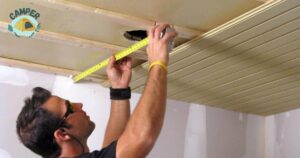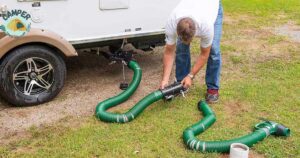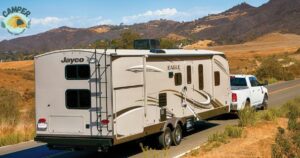Truck camper jacks are devices that stabilize and lift campers off pickup trucks, ensuring a level and secure foundation. Available in types like scissors or electric jacks, they play a vital role in providing stability during camping and enhancing comfort and safety.
Loading a truck camper without jacks can be a challenging task, requiring careful planning and precision. Here, the question arises how to load a truck camper without jacks? Without the support of jacks, ensuring a balanced and level placement becomes crucial for a smooth loading process. It demands a steady hand and attention to detail to safely load the camper onto the truck bed without the aid of stabilizing jacks.
Begin by positioning the camper close to the truck bed and ensuring a level surface. Use a spotter for guidance and slowly drive the camper onto the truck bed, maintaining balance. After loading, double-check the arrangement and secure the camper with tie-downs to ensure stability without the use of jacks.
Assessing Your Setup
Loading a truck camper without jacks requires careful assessment of your setup. Begin by checking the truck’s suspension to ensure it can handle the camper’s weight.
Examine the camper’s balance to avoid uneven distribution. Assess the truck bed for any obstacles or items that might affect loading. Take note of the ground conditions to prevent sinking or instability.
Double-check that all connections and attachments are secure before loading. Utilize a spotter to guide you and ensure a smooth loading process. Regularly assess your setup to maintain safety and prevent damage.
Truck and camper weight capacities
When loading a camper onto a truck, know the truck’s payload capacity and adhere to the Gross Vehicle Weight Rating (GVWR). Be aware of the camper’s weight, ensuring it falls within the truck’s towing capacity.
Avoid exceeding the Gross Combined Weight Rating (GCWR) to maintain safety. Check the camper’s tongue weight and distribute the load evenly for balanced towing. Overloading can compromise performance and safety.
So always follow the specified weight limits. Regularly assess and adhere to weight capacities for a safe and trouble-free travel experience.
Compatibility check
Before loading a pop-up camper onto your truck, perform a thorough compatibility check. Confirm that the camper’s weight is within the truck’s towing capacity. Check the truck’s payload capacity and ensure it can handle the camper’s load.
Verify the camper’s dimensions to ensure it fits securely in the truck bed. Examine hitch compatibility and confirm a proper connection. Double-check weight distribution to maintain balance. A meticulous compatibility check ensures a safe and successful camper loading process.
Ensuring a stable loading surface
Ensuring a stable loading surface is essential when loading a camper onto a truck. Start by choosing a level and solid ground to minimize the risk of instability. Check for any uneven terrain or soft spots that could affect the loading process.
If possible, use a level to confirm that the surface is flat. Avoid loading on inclines or declines to maintain stability. Taking the time to secure a stable loading surface contributes to a safer and smoother camper loading experience.
Pre-Loading Prep
Before loading a camper onto a truck, follow these essential pre-loading preparations:
- Verify that the camper’s weight aligns with the truck’s towing capacity to prevent overloading.
- Ensure the truck is in good condition, and its suspension can handle the additional weight.
- Choose a level and stable loading surface, avoiding uneven terrain or soft ground.
- Remove any obstacles from the loading area to prevent interference during the process.
- Confirm the hitch is compatible and securely attached to both the truck and camper.
- Assess the camper’s balance and distribute the weight evenly for stable towing.
By completing these pre-loading preparations, you enhance safety and efficiency when loading the camper onto the truck.
Camper condition check
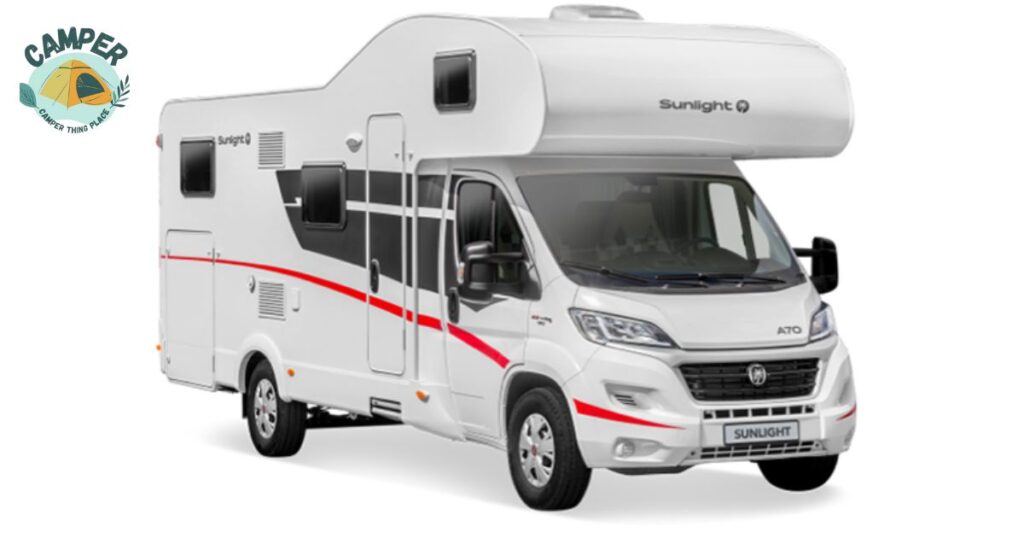
Before you load your camper, check its condition. Look for any visible damage or wear on the exterior. Ensure that the tires are properly inflated and show no signs of excessive wear. Check the hitch and connections to make sure they are secure.
Inside, inspect for loose items that could shift during transit. Confirm that all doors and windows are securely closed. Also, check the camper’s overall weight distribution for a balanced load. Taking these steps helps ensure a safe and smooth journey without relying on jacks for inspection.
Prioritizing stability
Prioritizing stability is essential for a safe and smooth journey, especially when loading a camper without jacks. Start by ensuring the camper’s weight is evenly distributed, avoiding imbalances that can affect stability.
Check and tighten all tie-downs to secure the camper firmly in place. Inspect the tires for proper inflation and look for any signs of wear. Confirm that the hitch and connections are securely fastened.
Inside the camper, secure loose items to prevent shifting during transit. Prioritizing stability during the loading process is key to enhancing overall safety and minimizing the risk of accidents while on the road.
Weight Distribution
Loading a truck camper without using jacks can affect its weight distribution. When you load the camper, it’s important to evenly distribute the weight. Uneven weight distribution can lead to stability issues on the road.
Without jacks, be cautious about overloading one side. This imbalance may impact the handling of the truck and camper combination. To ensure safe travel, strive for an equal weight distribution on both sides.
Check the camper’s manual for recommended loading guidelines. Keep in mind that a balanced weight distribution contributes to a smoother and safer driving experience, even without jacks.
Even cargo placement
When loading your Pop-Up Camper without utilizing jacks, it’s crucial to consider the placement of cargo inside the truck camper. Distribute the weight evenly from front to back and side to side. Avoid concentrating heavy items on one side, as it can lead to imbalanced weight distribution.
This thoughtful approach ensures a well-balanced and stable setup for your Pop-Up Camper, promoting safer travels and preventing potential issues associated with uneven weight distribution.
A well-balanced cargo placement ensures stability and better handling on the road, enhancing the safety of your journey. Take extra care to organize and secure your belongings to maintain equilibrium, even without the assistance of jacks.
Optimal balance tips
Achieving optimal balance when loading a truck camper without jacks involves a few key tips:
- Aim for an equal distribution of weight from front to back and side to side. This prevents the camper from leaning to one side and helps maintain stability.
- Place heavier items closer to the center of the camper floor and toward the bottom. This lowers the camper’s center of gravity, reducing the risk of tipping.
- Use tie-downs or other securing methods to keep items in place. This prevents shifting during travel, maintains balance, and prevents sudden weight shifts.
- Be aware of the camper’s design and load capacity. Follow the manufacturer’s guidelines for optimal loading to ensure safety and stability.
- Periodically check the weight distribution during your journey. Adjust if necessary to maintain balance, especially after making stops or changes to your cargo.
- Avoid loading too much weight towards the rear of the camper. A front-heavy balance contributes to better steering control and stability.
- If possible, conduct a test drive before embarking on a longer journey. This allows you to assess the camper’s handling and make adjustments if needed.
By paying attention to these tips, you can enhance the balance of your truck camper even when loading without jacks, contributing to a safer and more comfortable travel experience.
Aligning the camper with the truck bed
Aligning the camper with the truck bed is essential for safe towing. Ensure the camper is centered both widthwise and lengthwise, maintaining a level position using leveling tools if needed.
Check hitch compatibility, achieve the recommended overhang, and secure all connections. A final walk-around confirms alignment and secure attachment, contributing to a safe and stable towing experience.
Loading Process
Loading a camper without jacks can be a straightforward process. First, make sure the camper is on a flat surface to ensure stability. Open the camper door and clear the entryway of any obstacles.
Slowly and carefully, guide the camper into the loading position using a towing vehicle. Take your time to avoid any sudden movements. Once in place, secure the camper to the towing vehicle with appropriate attachments.
Double-check that everything is stable before hitting the road. Remember, safety is key during the loading process of a camper without jacks.
Step-by-step loading without jacks
- Choose a level and stable surface for loading your camper without jacks. This ensures a safe and even loading process.
- Open the camper door and remove any obstacles from the entryway. Clear the path to make the loading process smoother.
- Slowly guide the camper towards the towing vehicle, ensuring a straight and centered alignment. Take your time to avoid any sudden movements that could lead to instability.
- Confirm that there is enough clearance between the camper and the towing vehicle. Ensure that the camper is properly aligned for hitching.
- Once in position, securely attach the camper to the towing vehicle using the appropriate hitching system. This may include hitching bars, chains, or other attachments depending on your setup.
- Double-check that all connections are secure and that the camper is properly attached to the towing vehicle. Confirm stability before moving forward.
- Before hitting the road, perform a brief test to ensure that the camper is stable and securely attached to the towing vehicle.
- Drive slowly and attentively, especially during the initial moments after loading. Be cautious of any changes in stability and adjust as needed.
Alternative elevation and alignment methods
Loading a camper can be easier with alternative elevation and alignment methods. One approach is using ramps to elevate the camper gently.
This helps in avoiding steep inclines that might be challenging. Another method involves aligning the camper by using a spotter to guide the driver accurately. Clear communication is key to ensuring a smooth alignment process.
Additionally, using leveling blocks or jacks can provide a stable base for the camper, aiding in both elevation and alignment. These alternative methods offer practical solutions for loading a camper safely and efficiently.
Gradual and controlled loading
For safe loading, choose gradual inclines and control the process carefully. Utilize ramps with a gentle slope to avoid sudden shifts.
Employ a spotter for clear communication between the driver and guide. Prioritizing a slow and steady approach ensures a secure and accident-free loading of the camper.
Tie-Downs and Stability Check
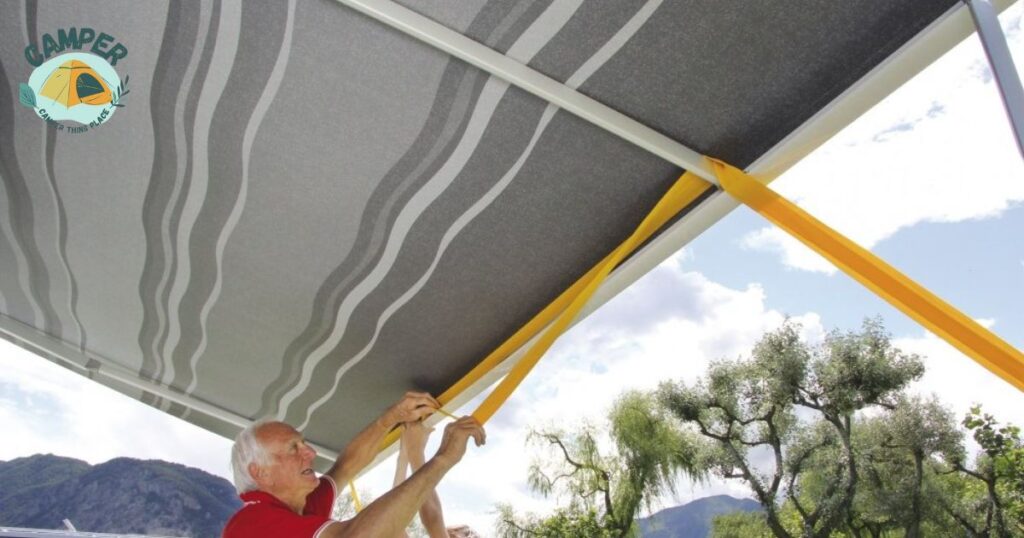
After loading your camper, secure it with proper tie-downs for stability. Use sturdy straps and ensure they are tightened securely to prevent shifting during transit.
Conduct a thorough stability check by gently rocking the camper to ensure it’s firmly in place. Regularly inspect tie-downs during the journey to maintain a secure and stable load.
Securing the camper
Secure the camper by using reliable tie-downs. Double-check that all straps are tightly fastened to prevent any movement during transportation.
Confirm the stability by gently testing for any rocking or shifting. Regularly monitor and tighten tie-downs as needed to ensure a consistently secure and safe transport of the camper.
Checking stability during and after loading
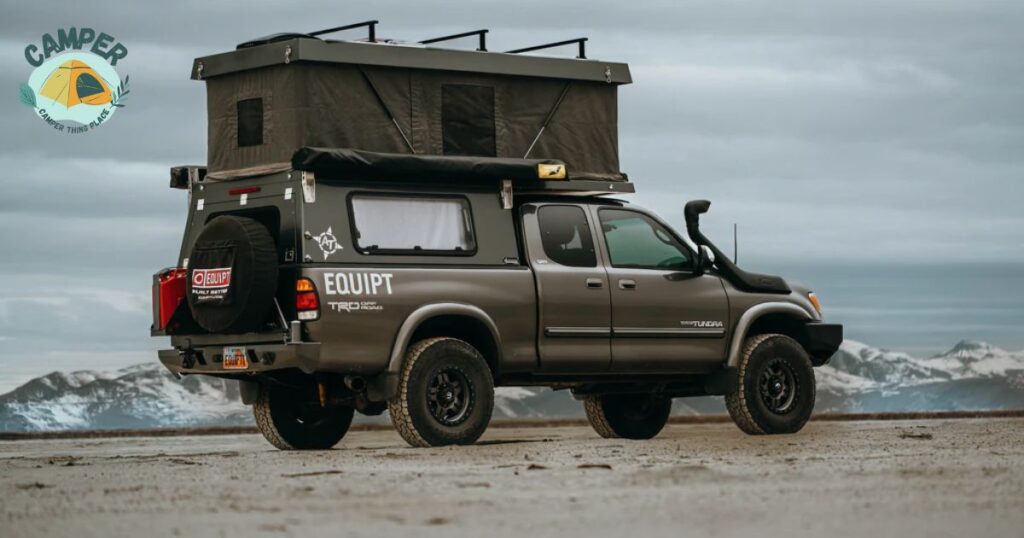
Continuously assess stability while loading and afterward. Confirm secure placement by gently rocking the camper to detect any movement. Double-check tie-downs and make necessary adjustments for a stable and safe load.
This ongoing monitoring ensures that the camper remains securely in place throughout the journey and minimizes the risk of any shifting or instability.
Addressing instability issues
If instability issues arise during or after loading, reassess tie-downs and make necessary adjustments. Ensure all straps are tightly secured, and consider redistributing the load for better balance.
If instability persists, check for any underlying issues with the camper’s weight distribution or equipment. Addressing these concerns promptly helps maintain stability and ensures a safe and smooth journey with your camper.
Maintenance Tips
Here are some easy maintenance tips to make it hassle-free. First, check the camper’s weight limit to avoid overloading. Position the camper near a stable surface for better support. Ensure tires are properly inflated for a smooth loading process.
Use a level to make sure the camper is balanced before loading. When loading, distribute weight evenly to prevent strain on one side. If possible, have a helper guide you for better precision.
Inspect the camper’s suspension and frame regularly for wear and tear. Lubricate moving parts to reduce friction and extend the camper’s lifespan. By following these simple tips, you’ll keep your camper in good shape without a jack.
Seeking Professional Help
If you’re unsure about loading your camper without a jack, seeking professional help is a wise decision. A qualified mechanic or RV technician can provide valuable guidance. They can assess your camper’s weight capacity and offer advice on safe loading practices.
Professionals can also inspect your camper’s suspension and frame, ensuring they are in optimal condition. If you’re unfamiliar with weight distribution, a specialist can assist in achieving a balanced load.
Don’t hesitate to reach out to experts for hands-on assistance and peace of mind when loading your camper without a jack.
Recognizing when to consult experts
Recognizing when to consult experts for loading your camper is vital for a smooth and secure experience. If you lack experience, have concerns about weight distribution, or notice any mechanical issues, it’s wise to seek professional assistance.
Safety should always be a top priority, especially in complex loading scenarios or challenging conditions. By reaching out to a qualified mechanic or RV technician, you can ensure that your camper is loaded correctly.
Preventing potential issues and enhancing your overall camping experience. Don’t hesitate to rely on experts to provide the guidance and expertise needed for a safe and enjoyable journey.
Advice on specific concerns
If you have specific concerns about loading your camper without a jack, prioritize weight distribution, regularly check the suspension for wear, and maintain proper tire pressure.
Seek advice from professionals on handling challenging terrains and ensuring a balanced load. Their expertise will not only address specific concerns but also contribute to a safer and more enjoyable camper loading experience.
Professional inspections for safety
Professional inspections play a crucial role in ensuring the safety of your camper. Certified technicians can assess critical components such as the suspension, brakes, and frame for any signs of wear or damage.
They also verify that weight distribution is optimal, preventing potential hazards on the road. Regular inspections contribute to the early detection of issues, enhancing overall safety and peace of mind during your camper adventures.
How Do You Stabilize A Truck Camper Off A Truck?
To stabilize a truck camper off a truck:
Use Stabilizer Jacks:
Deploy stabilizer jacks on all four corners of the camper to provide additional support and prevent swaying.
Chock the Wheels:
Place wheel chocks on both sides of the camper’s tires to prevent any accidental rolling or movement.
Level the Camper:
Ensure the camper is parked on a level surface to enhance stability and make it more comfortable for occupants.
Remember, proper stabilization enhances safety and comfort when using a truck camper off the truck.
Frequently Asked Questions
How To Load A Truck Camper By Yourself?
Carefully position and secure the truck camper onto the bed using a camper loading system or enlist the help of ramps and a spotter for safe and solo loading.
What are alternative methods for loading a camper onto a truck without jacks?
Ramps, pulleys, or assistance from others are viable alternatives for loading a truck camper without jacks.
Can I damage my truck or camper by loading without jacks?
Yes, improper loading can cause damage. Follow proper procedures and use appropriate tools to prevent any potential harm.
What steps should I follow to safely load a truck camper without jacks?
Ensure the camper is balanced, use sturdy ramps or alternative methods, and follow a step-by-step loading process and guidance of any expert to ensure safety
Final Thoughts
Loading a truck camper without jacks can be done safely and efficiently. Begin by ensuring the truck is on a level surface. Use a friend to help guide and stabilize the camper as you lift it.
Take your time and lift each corner gradually, distributing the weight evenly. So here we solve a problem about how to load a truck camper without a jack. Utilize a sturdy platform or ramps to bridge the gap between the truck bed and the camper. Double-check the alignment and make any necessary adjustments before fully securing the camper in place.
With patience and careful steps, loading a truck camper without jacks can be a smooth process, ensuring a secure and hassle-free adventure.

Jackson Ray, a seasoned blogger with a decade of experience, is the creative mind behind “camperthingsplace.com.” Explore his wealth of insights and passion for camping through engaging content on the website.


